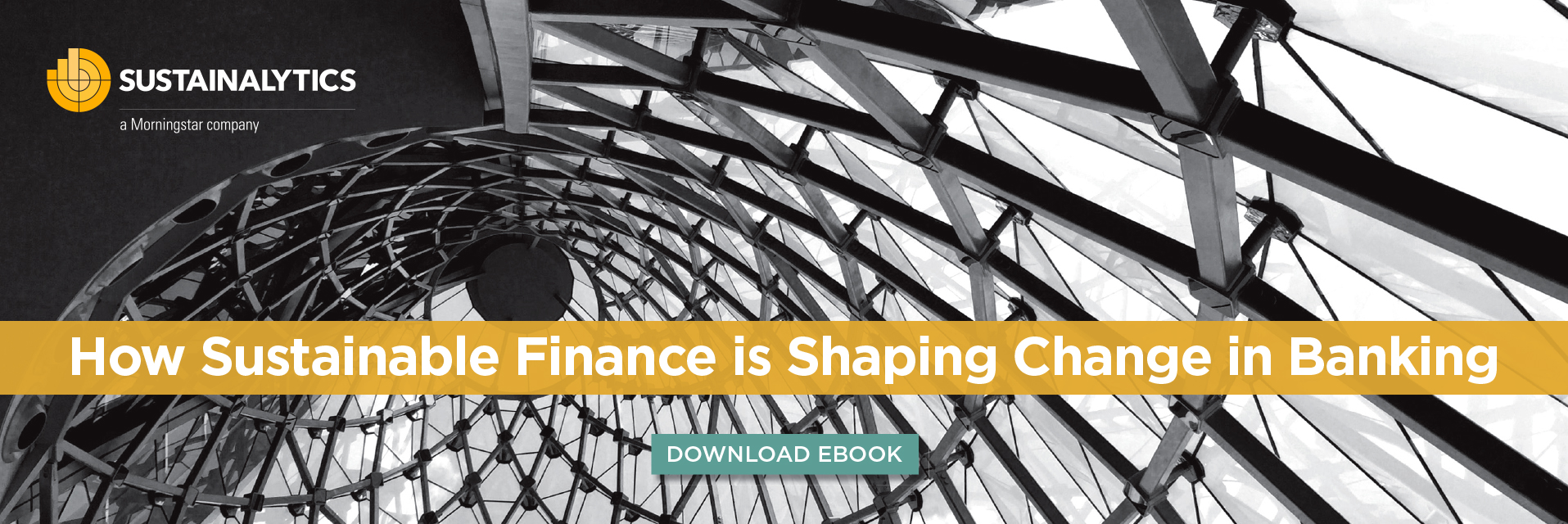Financing the Future: Conversations in Sustainable Finance is a Q&A series where we sit down with featured ESG experts from Sustainalytics, sharing their insights on how businesses are using finance to meet the challenges of our transition to a sustainable future.
Read on to learn how banks are using sustainable finance to encourage sustainability improvements among their clients and to reduce the negative ESG impacts of their own operations and investments.
Sustainalytics: Before we dive into the questions, can you tell readers a little bit about yourself and your work?
Mayur Mukati: My pleasure! I joined Sustainalytics in 2018 to write second-party opinions on green, social, and sustainable finance projects. Then I moved onto helping develop the technical assessments and methodology for our ever-expanding suite of opinion services, including transition bonds. Recently, I moved to the Corporate Solutions’ commercial team. In this new role, I act as a technical expert, assisting financial institutions and corporate clients with their increasingly complicated sustainable finance transactions.
My background is in chemical engineering and sustainability management. I’ve worked at a few different Fortune 500 firms in chemical and pharmaceutical manufacturing and with several non-governmental organizations on clean technology and climate change research programs funded by the Canadian government.
SUST: Thank you for that introduction, Mayur. Now onto the questions! What do you believe is a bank’s role in the global climate transition?
MM: In my view, the role of banks is to finance the global climate transition. Banks know that financial markets have a crucial role to play in transitioning to a green economy. Under the Glasgow Financial Alliance for Net Zero (GFANZ), which includes the Net-Zero Banking Alliance, more than 450 financial institutions, with a combined $130 trillion in assets, have committed to limit greenhouse gas emissions in line with a 1.5-degree scenario. This will mean facilitating trillions of dollars in sustainable loans, bonds, deposits, and other green transactions.
SUST: How are banks ensuring their efforts are meeting standards?
MM: The banks that have signed onto GFANZ are using the Paris Agreement as a starting point for a consistent, international approach to net-zero. GFANZ is also developing its own principles to promote alignment on measurement and disclosures, especially regarding carbon accounting, offsets, target-setting, and climate risk scenarios. These principles and other guidance are providing the consistency banks need to ensure they’re meeting the mutually accepted standards. They are also motivated by self-interest to meet their commitments. If they fail, they may lose business and damage their reputations.
SUST: In your opinion, what portfolios and approaches should banks be thinking of to support decarbonization?
MM: Banks’ commitments to decarbonization will mean reducing emissions from their own operations (scope 1 and 2 emissions) and from their lending and investment portfolios (scope 3 emissions) in line with net-zero goals and science-based targets. Banks will need to set up or implement ambitious targets to significantly increase the proportion of overall investments in sustainable portfolios. This may be a daunting task, but it will be worthwhile.
Products offered by banks also need to go greener to serve a large base of retail and institutional customers and partners that want green finance. This might mean providing innovative sustainable finance products, such as green deposits, lines of credit, and repurchase agreements.
SUST: Let’s move on to industry. How are banks supporting the decarbonization of the fossil fuel industry and avoiding greenwashing claims?
MM: Banks can play a crucial role in the climate transition by divesting from thermal coal companies. But it’s important for banks to use robust definitions of coal revenue thresholds and mid-term targets to determine which companies to divest and the timelines for divesting. When banks use their own definitions, they may not meet leading standards, like the Science-Based Targets. Working to meet international standards is also a key method to reduce the risk of greenwashing.
Another way lenders to fossil fuel companies should address stakeholder concerns around greenwashing is to engage with these companies to set robust and realistic targets. This could require oil and gas companies and consequently banks to account for relevant scope 3 emissions. This also means that banks and their clients may have to limit their reliance on carbon offsets and breakthrough technologies that are not yet scalable.
SUST: Outside of carbon offsets and technological solutions, how can sustainable finance help banks meet their climate targets?
MM: The sustainable finance market has grown tremendously in the last few years thanks, in part, to new instruments such as sustainability-linked loans and bonds. Sustainable finance can help banks meet their climate targets in a number of ways. I see two especially important factors.
First, financial corporations, such as banks, can accelerate ESG-related transactions within the market. Banks can focus on transactions that address clients’ largest impact areas, such as greenhouse gas reduction for hard-to-abate sectors. These challenging impact areas may not be easily achievable by clients within the observation period or maturity of the issued debt. However, banks can effectively support these clients’ sustainability efforts using performance indicators (KPIs) that include significant coverage of such impact areas from the client’s overall business.
Secondly, banks can set sustainability performance targets around their emissions as well as concretely defined sustainable portfolios that they expect to manage within the next decade. This is also where external review providers like Sustainalytics come into play. We can assess: i) the credibility of the definition of sustainable portfolios with a set of environmental and/or social criteria, and ii) the extent to which the bank is committing to increase the proportion of sustainable assets in its overall managed portfolios.
SUST: How important is sustainable finance in terms of a bank’s general climate change or net-zero strategy?
MM: In general, banks’ sustainable finance issuances support their broader climate transition strategies. But in terms of impact, these strategies are more comprehensive than the commitments outlined in individual transactions. After all, while sustainable finance transactions are essential, they are just one part of an issuer’s overall action plan for the implementation of its ESG strategies and underlying net-zero goals in the long term.
SUST: Thank you so much for this insightful conversation, Mayur! We look forward to hearing from you again.
To learn more about how banks are using sustainable finance in their strategies, click here or the banner below to read our ebook, How Sustainable Finance is Shaping Change in Banking.

Recent Content
Landmark Rules Ask Companies to Grapple With Climate Risk Very Publicly
Ron Bundy hosts an interview with Gabriel Presler, Global Head of Enterprise Sustainability at Morningstar and Aron Szapiro, Morningstar’s Head of Retirement Studies and Public Policy, to discuss what the new SEC rule and other climate regulations mean.
Financing the Future: An Interview on High ESG Risk Industries and Opportunities for Banks
Companies in industrial conglomerates, steel, diversified metals, precious metals, and oil and gas producers can make take meaningful steps to reduce their material environmental, social, and governance (ESG) risk – and the negative impacts that go along with those risks. But they need guidance and access to finance. Read on to learn how banks are working with clients in these high-risk industries to set and meet targets for material improvements on ESG risk factors.







